Schneider P., Eberly D.H. Geometric Tools for Computer Graphics
Подождите немного. Документ загружается.

584 Chapter 11 Intersection in 3D
If a triangle intersects a cone, it must do so either at a vertex, an edge point, or an
interior triangle point. The algorithm described here is designed to provide early exits
using a testing order of vertex-in-cone, edge-intersects-cone, and triangle-intersects-
cone. This order is a good one for an application where a lot of triangles tend to be
fully inside the cone. Other orders may be used depending on how an application
structures its world data.
To test if P
0
is inside the cone, it is enough to test if the point is on the cone side
of the plane a ·(X − V)≥ 0 and if the point is inside the double cone. Although the
test can be structured as
D0 = triangle.P0 - cone.V;
AdD0 = Dot(cone.A, D0);
D0dD0 = Dot(D0, D0);
if (AdD0 >= 0 and AdD0 * AdD0 >= cone.CosSqr * D0dD0)
triangle.P0 is inside cone;
if all the triangle vertices are outside the single cone, it will be important in the edge-
cone intersection tests to know on which side of the plane a ·(X −V)=0 the vertices
are. The vertex test is better structured as shown below. The term outside cone refers
to the quantity being outside the single cone, not the double cone (a point could be
outside the original single cone, but inside its reflection).
D0 = triangle.P0 - cone.V;
AdD0 = Dot(cone.A, D0);
if (AdD0 >= 0) {
D0dD0 = Dot(D0, D0);
if (AdD0 * AdD0 >= cone.CosSqr * D0dD0) {
triangle.P0 is inside cone;
} else {
triangle.P0 is outside cone, but on cone side of plane;
}
} else {
triangle.P0 is outside cone, but on opposite side of plane;
}
All three vertices of the triangle are tested in this manner.
If all three vertices are outside the cone, the next step is to test if the edges
of the triangle intersect the cone. Consider the edge X(t) = P
0
+ t e
0
,wheree
0
=
P
1
− P
0
and t ∈ [0, 1]. The edge intersects the single cone if a ·(X(t) − V)≥ 0 and
(a · (X(t) − V))
2
−γ
2
X(t) − V
2
=0 for some t ∈[0, 1]. The second condition is
a quadratic equation, Q(t) = c
2
t
2
+ 2c
1
t + c
0
= 0, where c
2
= (a ·e
0
)
2
− γ
2
e
0
2
,
c
1
=(a ·e
0
)(a ·
'
0
) − γ
2
e
0
·
'
0
, and c
0
=(a ·
'
0
)
2
−γ
2
'
0
2
,where
' = P
0
−V .
The domain of Q(t) for which a root is sought depends on which side of the plane
the vertices lie.
11.7 Planar Components and Quadric Surfaces 585
If both P
0
and P
1
are on the opposite side of the plane, then the edge cannot
intersect the single cone. If both P
0
and P
1
are on the cone side of the plane, then
the full edge must be considered, so we need to determine if Q(t) = 0 for some
t ∈ [0, 1]. Moreover, the test should be fast since we do not need to know where the
intersection occurs, just that there is one. Since the two vertices are outside the cone
and occur when t = 0 and t = 1, we already know that Q(0)<0 and Q(1)<0. In
order for the quadratic to have a root somewhere in [0, 1], it is necessary that the
graph be concave, since if it were convex, the graph would lie below the line segment
connecting the points (0, Q(0)) and (1, Q(1)). This line segment never intersects the
axis Q = 0. Thus, the concavity condition is c
2
< 0. Additionally, the t-value for the
local maximum must occur in [0, 1]. This value is
ˆ
t =−c
1
/c
2
. We could compute
ˆ
t
directly by doing the division; however, the division can be avoided. The test 0 ≤
ˆ
t ≤1
is equivalent to the test 0 ≤ c
1
≤−c
2
since c
2
< 0. The final condition for there to
be a root is that Q(
ˆ
t) ≥ 0. This happens when the discriminant for the quadratic is
nonnegative: c
2
1
− c
0
c
2
≥ 0. In summary, when P
0
and P
1
are both on the cone side
of the plane, the corresponding edge intersects the cone when
c
2
< 0 and 0 ≤c
1
≤−c
2
and c
2
1
≥ c
0
c
2
If P
0
is on the cone side and P
1
is on the opposite side, the domain of Q can be
reducedto[0,
˜
t], w h er e P
0
+
˜
t e
0
is the point of intersection between the edge and the
plane. The parameter value is
˜
t =−(a ·
'
0
)/(a ·e
0
). If this point is V and it is the only
intersection of the edge with the cone, at first glance the algorithm given here does not
appear to handle this case because it assumes that Q<0 at the end points of the edge
segment corresponding to [0,
˜
t]. It appears that Q(
˜
t) = 0 and c
2
≥ 0 are consistent
to allow an intersection. However, the geometry of the situation indicates the line
containing the edge never intersects the cone. This can only happen if Q(t) ≤ 0, so
it must be the case that c
2
< 0 occurs. Now we analyze when Q has roots on the
interval [0,
˜
t]. As before, c
2
< 0 is a necessary condition since Q(0)<0 and Q(
˜
t)< 0.
The t-value for the local maximum must be in the domain 0 ≤
ˆ
t ≤
˜
t. To avoid the
divisions, this is rewritten as 0 ≤ c
1
and c
2
(a ·
'
0
) ≤ c
1
(a ·e
0
). The condition that
the discriminant of the quadratic be nonnegative still holds. In summary, when P
0
is
on the cone side and P
1
is on the opposite side, the corresponding edge intersects the
cone when
c
2
< 0 and 0 ≤c
1
and c
2
(a ·
'
0
) ≤ c
1
(a ·e
0
) and c
2
1
≥ c
0
c
2
Finally, if P
1
is on the cone side and P
0
is on the opposite side, the domain for Q
isreducedto[
˜
t, 1]. Once again the graph must be concave, the discriminant of the
quadratic must be nonnegative, and
ˆ
t ∈ [
˜
t, 1]. The edge intersects the cone when
c
2
< 0 and c
1
≤−c
2
and c
2
(a ·
'
0
) ≤ c
1
(a ·e
0
) and c
2
1
≥ c
0
c
2
All three edges of the triangle are tested in this manner.
586 Chapter 11 Intersection in 3D
If all three edges are outside the cone, it is still possible that the triangle and
cone intersect. If they do, the curve of intersection is an ellipse that is interior to the
triangle. Moreover, the axis of the cone must intersect the triangle at the center of that
ellipse. It is enough to show this intersection occurs by computing the intersection
of the cone axis with the plane of the triangle and showing that point is inside the
triangle. Of course this test does not need to be applied when all three vertices are on
the opposite side of the plane—another early exit since it is known by this time on
which side of the plane the vertices lie.
A triangle normal is n =e
0
×e
1
. The point of intersection between cone axis
V +s a and plane n · (X −P
0
) = 0, if it exists, occurs when s =(n ·
'
0
)/(n ·a).The
point of intersection can be written in planar coordinates as
V + s a =P
0
+ t
0
e
0
+ t
1
e
1
or
(n ·
'
0
)a −(n ·a)
'
0
= t
0
(n ·a)e
0
+ t
1
(n ·a)e
1
Define u = (n ·
'
0
)a −(n ·a)
'
0
.Tosolvefort
0
, cross the equation on the right
with e
1
, then dot with n. Similarly solve for t
1
by crossing on the right with e
0
and
dotting with n. The result is
t
0
(n ·a)n
2
=n ·u ×e
1
and t
1
(n ·a)n
2
=−n ·u ×e
0
To be inside the triangle it is necessary that t
0
≥0, t
1
≥0, and t
0
+t
1
≤1. The compar-
isons can be performed without the divisions, but require two cases depending on the
sign of n ·a. In the code, the quantities n, n ·a, n ·
'
0
, u, and n ×u are computed.
If n ·a ≥0, then the point is inside the triangle when n ×u ·e
0
≤ 0, n ×u ·e
1
≥ 0,
and n ×u ·e
2
≤ (n ·a)n
2
. The inequalities in these three tests are reversed in the
case n ·a ≤0.
Find Intersection
The analysis in the previous section can be extended to actually partition the triangle
into the component inside the cone and the component outside. The curve of sepa-
ration will be a quadratic curve, possibly a line segment. If the triangle is represented
as X(s, t) = P
0
+ s e
0
+ t e
1
for s ≥0, t ≥ 0, and s + t ≤ 1, the points of intersetion
of the single cone and triangle are determined by
a ·(X(s, t) − V)≥ 0 and (a · (X(s, t) − V))
2
− γ
2
X(s, t)
2
= 0
If any portion of the triangle satisfies the linear inequality, this trims down the tri-
angle domain to a subset: the entire triangle, a subtriangle, or a subquadrilateral. On
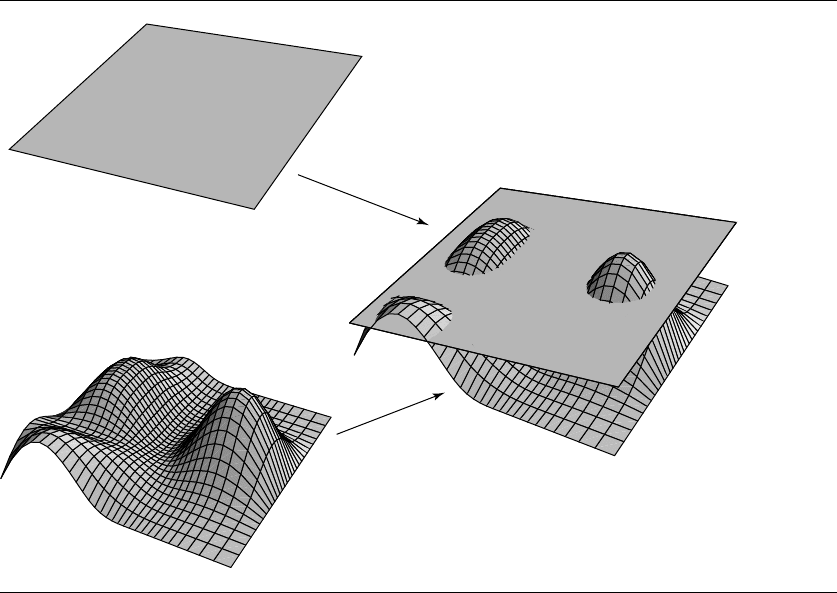
11.8 Planar Components and Polynomial Surfaces 587
that subdomain the problem is to determine where the quadratic function is zero.
Thus, the problem reduces to finding the intersection in 2D of a triangle or quadri-
lateral with a quadratic object. Locating the zeros amounts to actually finding the
roots of Q(t ) for the edges of the triangle discussed in the previous section, and/or
determining the ellipse of intersection if the cone passes through the triangle interior.
11.8
Planar Components and Polynomial
Surfaces
In this section we cover the problem of intersecting a plane with a polynomial surface,
an example of which can be seen in Figure 11.53.
A very general way to represent a polynomial surface is in rational parametric
form
Figure 11.53 Intersection of a plane and a parametric surface.

588 Chapter 11 Intersection in 3D
x =
x(s, t)
w(s, t)
y =
y(s, t)
w(s, t)
z =
z(s, t)
w(s, t)
(11.27)
where the polynomials x(s, t), y(s, t), and z(s, t) may be in monomial, B
´
ezier, B-
spline, or other piecewise polynomial basis. Given this, two general methods may be
employed to find the intersection of such a polynomial surface with a plane.
One method is to apply a series of transformations (rotation and translation) to
map the intersecting plane into the XY plane. The same transformation applied to
the polynomial surface results in
x
=
x
(s, t)
w
(s, t)
y
=
y
(s, t)
w
(s, t)
z
=
z
(s, t)
w
(s, t)
The equation z
= 0 now represents the intersection in the parameter space of the
rational polynomial surface.
The other method works the other way around—substitute the parametric equa-
tions of the polynomial surface into the plane equation
ax + by + cz + d = 0
If we substitute the expressions in Equation 11.27 into this plane equation, we get
ax(s, t) + by(s, t) + cz(s, t) + dw(s, t) = 0
the equation of the intersection curve in the parameter space of the surface.
We could also simply treat the plane–polynomial surface intersection problem as
just an instance of the general surface-surface intersection problem (Section 11.10).
Owing to the low degree of the plane, and the fact that the plane is of course flat, such
an approach would probably be relatively reliable. However, we can more directly take
advantage of the fact that one of the surfaces is a plane and derive a more efficient
and robust algorithm for this special case. Two such algorithms are found in Boeing
(1997) and Lee and Fredricks (1984). We present the latter here.
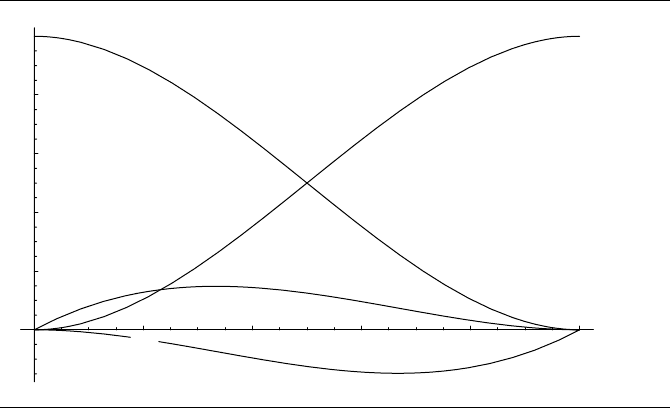
11.8 Planar Components and Polynomial Surfaces 589
11.8.1 Hermite Curves
The intersection method we’ll describe produces an (approximate) intersection curve
using the Hermite form, and so we provide a brief review of this representation.
A Hermite curve is defined by its two end points P
0
and P
1
and two tangent
vectors
d
0
and
d
1
. The cubic Hermite basis functions are
a
0
(t) = 2t
3
− 3t
2
+ 1
a
1
(t) =−2t
3
+ 3t
2
b
0
(t) = t
3
− 2t
2
+ t
b
1
(t) = t
3
− t
2
The basis functions are shown in Figure 11.54.
The curve is a linear combination of the points and tangents, using the (cubic)
Hermite basis functions a
0
(t), a
1
(t), b
0
(t), and b
1
(t) :
C(t) = a
0
(t)P
0
+ a
1
(t)P
1
+ b
0
(t)
d
0
+ b
1
(t)
d
1
0.2 0.4 0.6 0.8 1
0.2
0.4
0.6
0.8
1
Figure 11.54 Hermite basis functions (cubic).
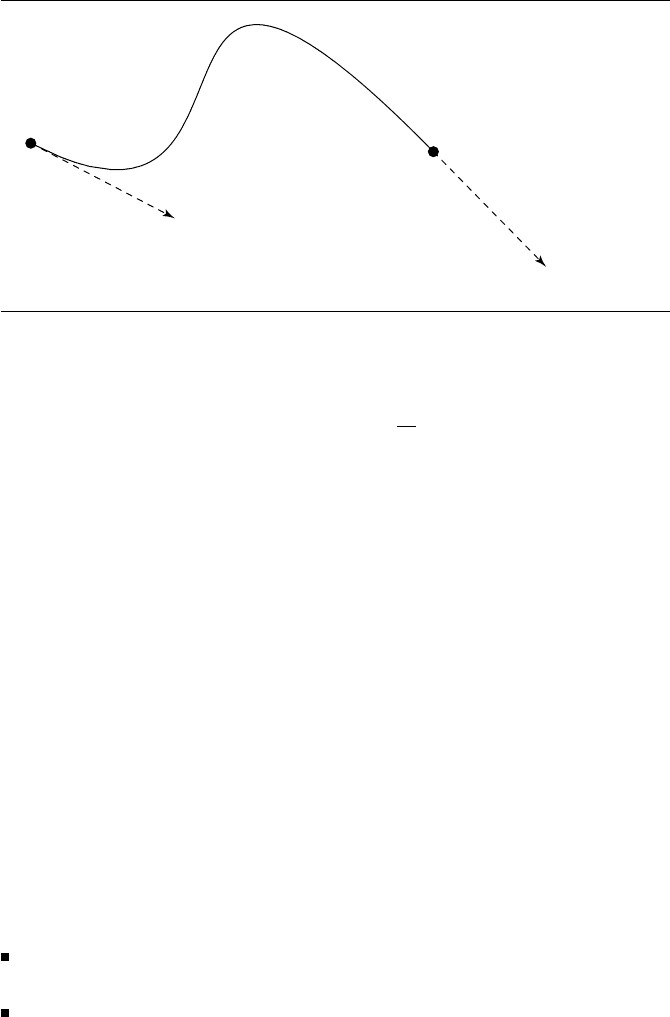
590 Chapter 11 Intersection in 3D
P
0
P
1
d
0
ˆ
d
1
ˆ
Figure 11.55 Cubic Hermite curve, specified by end points and tangents.
An example of such a curve is shown in Figure 11.55. (Note that the tangents are not
drawn to scale for space reasons;
d
0
should be
√
10 times as long as drawn, and
d
1
should be 5 times as long as drawn.)
11.8.2 Geometry Definitions
We’re interested in the intersection of a plane P and a parametric surface S defined
as S(u, v). For convenience of discussion, we assume that the parameter domains are
0 ≤ u, v ≤ 1. A surface may be viewed as the union of a number of subpatches, and
this algorithm concentrates on the intersection of a subpatch with P; the complete
intersection is found by finding the intersection curves for each subpatch and con-
catenating these curves into one or more intersection curves for the entire surface. A
subpatch is denoted by its corners in parameter space (a, b, c, d),where(a, b) are the
coordinates of the lower-left corner and (c, d) are the coordinates of the upper-right
corner, as shown in Figure 11.56.
Let the intersection of the surface S and the plane P be R(t), and let its preimage
be p(t) = [
u(t) v(t )
]. We wish to find a curve that approximately solves R(t) =
S(p(t)). The algorithm consists of a two-stage recursive method that computes cubic
Hermite approximations to (segments of) R(t) and p(t). Note that the Hermite curve
segments, whose union comprises the intersection curves proper, is a curve defined
in 3-space. The approximation criteria are as follows:
For p(t), an approximation is considered “sufficient” if its corresponding image
in 3-space is in the plane P.
For R(t), an approximation is considered “sufficient” if it is within a specified
tolerance of the 3-space image of the corresponding parameter space segment.
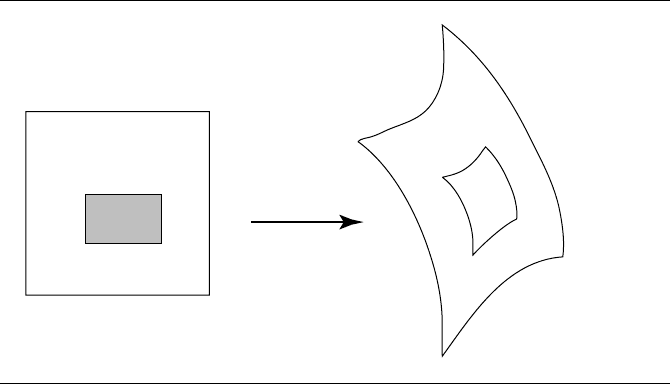
11.8 Planar Components and Polynomial Surfaces 591
(1, 1)
(a, b)
(c, d )
S(a, b)
S(c, d )
(0, 0)
Figure 11.56 A subpatch in parameter space maps to a topologically rectangular region on the
patch. After Lee and Fredricks (1984).
11.8.3 Computing the Curves
Recalling that we’re using a cubic Hermite curve, the tangent vector of R(t) is
R
(t) = S
u
(p(t))u
(t) + S
v
(p(t))v
(t) (11.28)
where S
u
(p(t)) and S
v
(p(t)) are the partial derivatives with respect to u and v at pa-
rameter t, and u
and v
are the components of the tangent vector of p at parameter t.
Because all points in R(t) must lie in P, it must be the case that
R
(t) ·ˆn =0
where ˆn is the unit normal to P. Substituting Equation 11.28, we have
S
u
(p(t)) ·ˆn
+
S
v
(p(t)) ·ˆn
Atapointp(t), this equation gives us the tangents for R(t). The (initial) estimates
of the lengths are computed by estimating one of u
(t) or v
(t), and solving for the
other one. The estimates are refined by making sure that the image of the midpoint
of p(t) is contained in P.
Figures 11.57 and 11.58 show the curves R(t) ={P
0
, P
1
,
d
0
,
d
1
} and p(t) =
{(u
0
, v
0
), (u
1
, v
1
), (u
0
, v
0
), u
1
, v
1
}, respectively (again, the tangent vectors are not
drawn to scale).
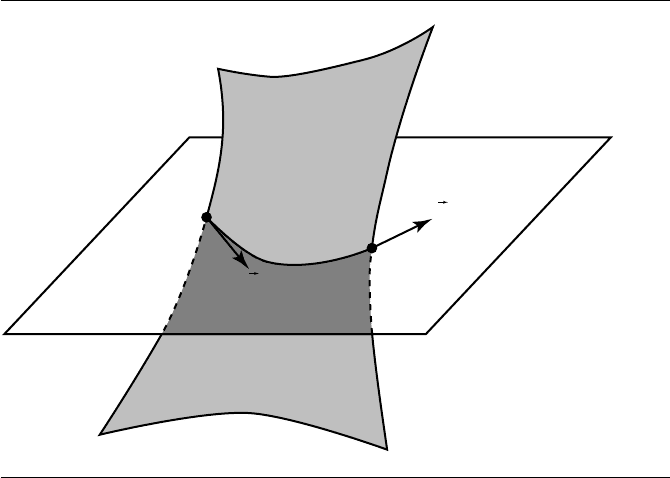
592 Chapter 11 Intersection in 3D
P
0
P
1
d
0
d
1
Figure 11.57 3-space intersection curve R(t).
11.8.4 The Algorithm
The algorithm consists of three parts, the first two recursive. The first part subdivides
the surface S into subpatches, until either no intersections are found, or until a
subpatch is found that intersects P exactly twice along its (the patch’s) borders. Each
subpatch so found is then passed, along with the 3D intersection points along each of
the two intersecting borders, to the second recursive algorithm, which computes the
intersection curve (segment).
The pseudocode is as follows:
Find(S, P, a, b, c, d) {
// Compute intersections along borders, if any
hits = ComputeIntersectionWithPlane(u0, v0, u1, v1, border0, border1);
if (hits == 0) {
return;
}
// Check for two hits, on different borders
if (hits == 2 and border0 != border1) {
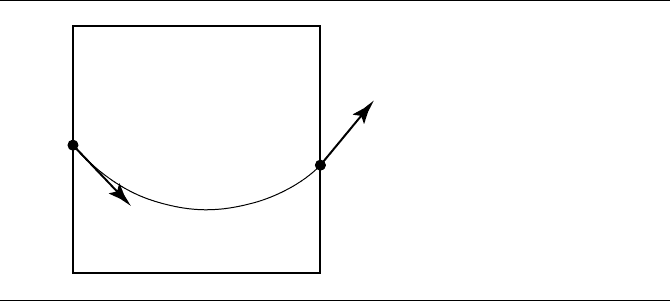
11.8 Planar Components and Polynomial Surfaces 593
(u
0
, v
0
)
(u
1
, v
1
)
(u'
0
, v'
0
)
(u'
1
, v'
1
)
Figure 11.58 Parametric space intersection curve p(t).
// Get the 3D points of the intersections
p0 = S(u0, v0);
p1 = S(u1, v1);
ComputeCurve(S, P, u0, v0, u1, v1, p0, p1);
} else {
// Split the subpatch in half, alternating
SplitSubPatch(S, a, b, c, d, parm, whichDirection);
// Recursively solve each half
if (whichDirection == uDir) {
Find(S, P, a, b, parm, d);
Find(S, P, parm, b, c, d);
} else {
Find(S, P, a, b, c, parm);
Find(S, P, a, parm, c, d);
}
}
}
The second part computes the intersection curve, recursively improving the ap-
proximation. As Lee and Fredricks (1984) note, the recursion is binary—that is, the
curve is checked at its midpoint, and if it fails to meet the convergence criteria, it is
split there and the algorithm recurses—but they suggest that it may be better to split
the curve into more than two pieces.
